This curation of IMPACT Resources offers insight into funders’ perspectives on evaluation and impact. These pieces highlight philosophies and approaches to evaluation and work to advance meaningful measurement and communication strategies.
NEW! Diving into Racial Equity: The MAP Fund’s Exploration By Vanessa Whang
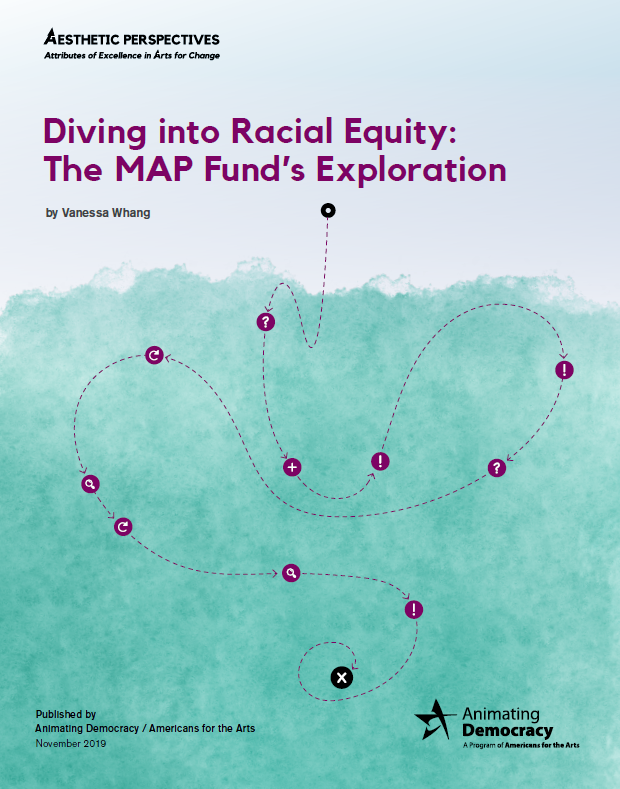 In 2015, the MAP Fund undertook a deep examination of one of its foundational priorities: racial equity in arts and culture grantmaking. In this case study by Vanessa Whang, follow MAP’s layered inquiry to examine biases in its: application platform, guidelines and requirements, applicant advisory supports and communications, and adjudication processes. Learn how MAP is incorporating the framework, Aesthetic Perspectives: Attributes of Excellence in Arts for Change to help mitigate aesthetic bias in proposal review, and what an evaluation revealed. Published by Animating Democracy in collaboration with the MAP Fund.
In 2015, the MAP Fund undertook a deep examination of one of its foundational priorities: racial equity in arts and culture grantmaking. In this case study by Vanessa Whang, follow MAP’s layered inquiry to examine biases in its: application platform, guidelines and requirements, applicant advisory supports and communications, and adjudication processes. Learn how MAP is incorporating the framework, Aesthetic Perspectives: Attributes of Excellence in Arts for Change to help mitigate aesthetic bias in proposal review, and what an evaluation revealed. Published by Animating Democracy in collaboration with the MAP Fund.
Storytelling and Social Change: A Strategy Guide for Grantmakers
by Paul VanDeCarr
 Storyttelling and Social Change Guide is a compilation of over 75 interviews with grantmakers, communication specialists and storytellers to show the various ways that grantmakers can successfully execute their vision in "narrative strategies." Produced by Working Narratives, an organization that works with movemets to tell stories to evoke change, this guide is a useful resource in understanding the lengths grantmaking plays in furthering advocacy and creating communication within funding systems.
Storyttelling and Social Change Guide is a compilation of over 75 interviews with grantmakers, communication specialists and storytellers to show the various ways that grantmakers can successfully execute their vision in "narrative strategies." Produced by Working Narratives, an organization that works with movemets to tell stories to evoke change, this guide is a useful resource in understanding the lengths grantmaking plays in furthering advocacy and creating communication within funding systems.
CASES & POINTS: A Summary of the Funder Exchange on Evaluating Arts & Social Impact
by Pam Korza and Barbara Schaffer Bacon
A May 22 Funder Exchange on Evaluating Arts & Social Impact, presented by Americans for the Arts’ Animating Democracy program and hosted by the Nathan Cummings Foundation, brought together funders, evaluation professionals, and arts practitioners to learn about concrete approaches and measures funders are using to understand the impact of arts and social change investments. The report features case studies about evaluation approaches that were presented by the Crossroads Fund, J.W. McConnell Family Foundation, Fledgling Fund, and Porch Light Initiative of the Mural Arts Program, Philadelphia.
Advancing Evaluation: Practices in Philanthropy
by Jane Wales; Luis A. Ubinas; Matt Bannick and Eric Hallstein; Judith Rodin and Nancy MacPherson; Paul Brest; James E. Canales and Kevin Rafter
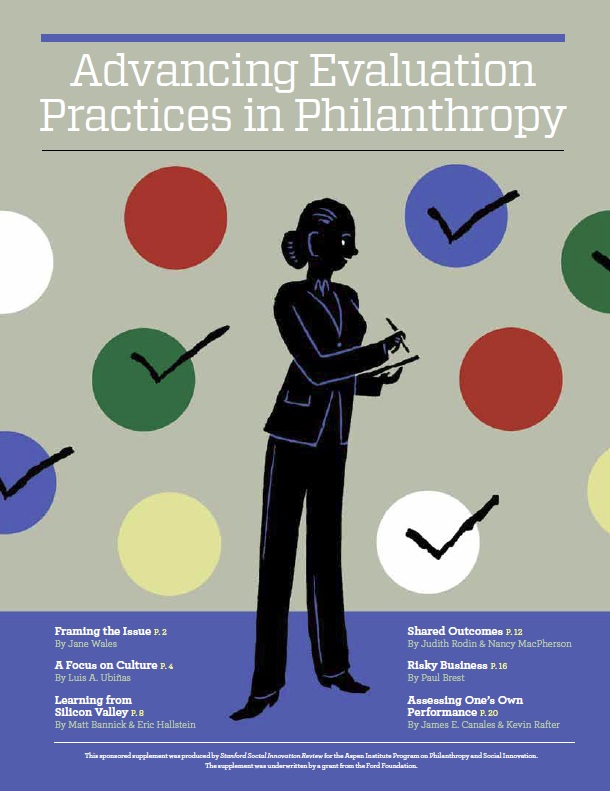 This piece sheds light on the philanthropic sector’s efforts to improve measurement and evaluation (M&E), specifically within the context of foundations involved in social change work. The broad observations of the six contributing authors are that purpose; cost-benefit ratio; culture, context and capacity; unit of analysis; timing; feedback; and transparency matter to measurement and evaluation.
This piece sheds light on the philanthropic sector’s efforts to improve measurement and evaluation (M&E), specifically within the context of foundations involved in social change work. The broad observations of the six contributing authors are that purpose; cost-benefit ratio; culture, context and capacity; unit of analysis; timing; feedback; and transparency matter to measurement and evaluation.
Build Your Advocacy Grantmaking: Advocacy Evaluation Tool & Advocacy Capacity Assessment Tool
by the Alliance for Justice
 Published by the Alliance for Justice, this highly useful, interactive guide has two major parts: the Advocacy Capacity Assessment Tool (13 pages) and the Advocacy Evaluation Tool (11 pages). The graphically pleasing guide is made for foundations and grantees to help improve evaluation methods given the difficulties of showing cause-and-effect between advocacy and policy change. A user-friendly introduction explains the purpose of the tools, suggested uses, a definition for advocacy, how the tools can guide grantmaking decisions, and how the tools can be customized.
Published by the Alliance for Justice, this highly useful, interactive guide has two major parts: the Advocacy Capacity Assessment Tool (13 pages) and the Advocacy Evaluation Tool (11 pages). The graphically pleasing guide is made for foundations and grantees to help improve evaluation methods given the difficulties of showing cause-and-effect between advocacy and policy change. A user-friendly introduction explains the purpose of the tools, suggested uses, a definition for advocacy, how the tools can guide grantmaking decisions, and how the tools can be customized.
Evaluating Social Innovation
by Hallie Preskill and Tanya Beer
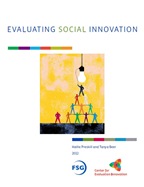 The authors suggest that traditional evaluation approaches (formative and summative) fail to meet the complex needs of social sector innovators. Instead, grantmakers should approach evaluation differently, specifically involving the use of developmental evaluation (attributed to Michael Quinn Patton). Through a review of literature, interviews, and case studies, this piece assists with putting developmental evaluation into practice.
The authors suggest that traditional evaluation approaches (formative and summative) fail to meet the complex needs of social sector innovators. Instead, grantmakers should approach evaluation differently, specifically involving the use of developmental evaluation (attributed to Michael Quinn Patton). Through a review of literature, interviews, and case studies, this piece assists with putting developmental evaluation into practice.
Handbook of Data Collection Tools: Companion to A Guide to Measuring Advocacy and Policy
by Jane Reisman, Anne Gienapp, Sarah Stachowiak
An outstanding piece, this 51-page handbook presents a great discussion of outcomes as they relate to policy and advocacy. Intended for grantmakers but useful for nonprofits as well, it encourages users to think about measurement of advocacy and policy efforts toward social change. It offers outcomes lists, examples of data collection tools, and many sample instruments from which users may benefit.
Measuring the Value of Corporate Philanthropy: Social impact, business benefits, and investor returns
by Terence Lim, Ph.D.
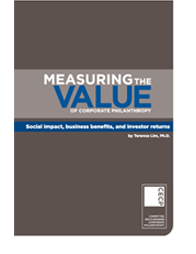 In answer to the challenges that face corporate philanthropy in identifying a shared definition of impact measurement, the author sets out to assess current measurement practices, clarify what is needed in terms of impact evidence, and identify next steps. The article is organized into three conversations between key stakeholders engaged in corporate philanthropy. Although this piece is written specifically for those involved in corporate philanthropy, it provides useful insights for cultural agents about measurement and outcomes of key concern to corporations with which they may partner or which may invest in arts for change work.
In answer to the challenges that face corporate philanthropy in identifying a shared definition of impact measurement, the author sets out to assess current measurement practices, clarify what is needed in terms of impact evidence, and identify next steps. The article is organized into three conversations between key stakeholders engaged in corporate philanthropy. Although this piece is written specifically for those involved in corporate philanthropy, it provides useful insights for cultural agents about measurement and outcomes of key concern to corporations with which they may partner or which may invest in arts for change work.
Philanthropy, Evaluation, Accountability, and Social Change
by John Bare, Ph.D.
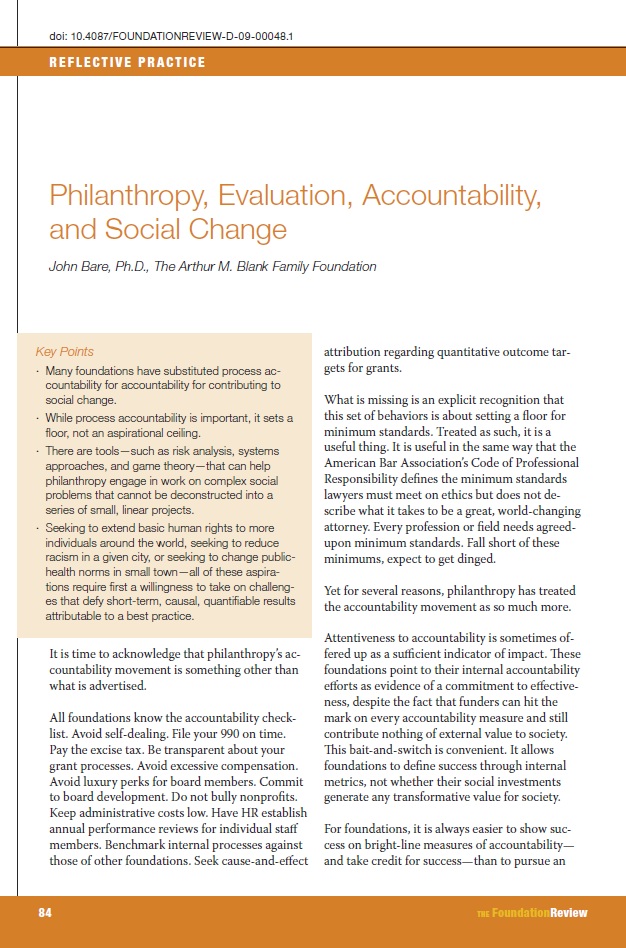 This piece suggests that the accountability movement is “setting a floor for minimum standards” and has consequences for effective social change work. Foundations, in particular, measure impact in terms of attentiveness to accountability standards, but this is a false measure of success. Instead, the organization’s focus should be on its transformative value to society.
This piece suggests that the accountability movement is “setting a floor for minimum standards” and has consequences for effective social change work. Foundations, in particular, measure impact in terms of attentiveness to accountability standards, but this is a false measure of success. Instead, the organization’s focus should be on its transformative value to society.
W.K. Kellogg Foundation Evaluation Handbook
by the W.K. Kellogg Foundation
 This 116-page handbook from the Kellogg Foundation provides a framework for thinking about evaluation as a relevant and useful program tool: “For those with little or no evaluation experience, and without the time or resources to learn more, this handbook can help project staff to plan and conduct an evaluation with the assistance of an external evaluator.” A blueprint for conducting project-level evaluations, this handbook is an excellent resource and was written primarily for project directors who have direct responsibility for ongoing evaluation.
This 116-page handbook from the Kellogg Foundation provides a framework for thinking about evaluation as a relevant and useful program tool: “For those with little or no evaluation experience, and without the time or resources to learn more, this handbook can help project staff to plan and conduct an evaluation with the assistance of an external evaluator.” A blueprint for conducting project-level evaluations, this handbook is an excellent resource and was written primarily for project directors who have direct responsibility for ongoing evaluation.